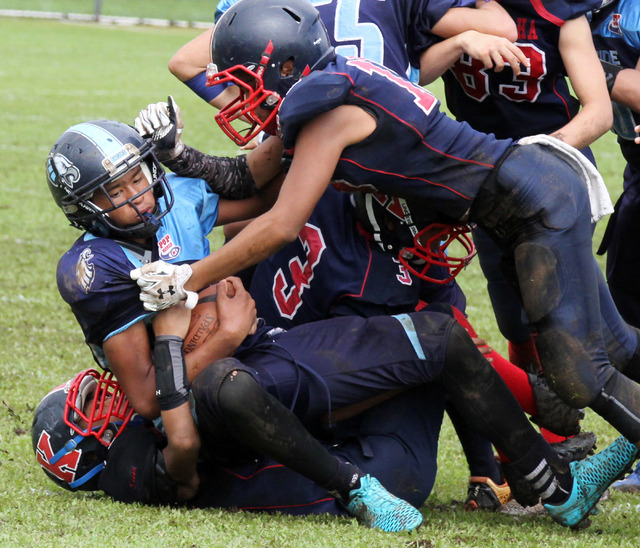It’s off in the distance, three months or so from now when Pop Warner and other forms of youth football start up once again across the country, but the question for parents should be asked now, while they have some time to consider options.
It’s off in the distance, three months or so from now when Pop Warner and other forms of youth football start up once again across the country, but the question for parents should be asked now, while they have some time to consider options.
We used to wonder how youngsters would do, whether the game would fill them with a new understanding of teamwork and respect for others, filling a role and being a part of something bigger than themselves.
More and more, the question parents face these days is whether they should let keiki get involved at all in the game of football. Maybe it’s better to develop a running program, find a soccer club to join, shoot hoops, grab a golf club and see how it feels.
There are an innumerable amount of things kids can do to stay active, but with all the publicity around concussions, dementia and other physical and mental side effects of too much football, at what point should children be considered ready for football?
This is the time of year parents would do well to give it some serious thought, rather than waiting until the week before turnouts.
“The common thing,” said Kel Lee, longtime Pop Warner coach with attachments to the Pahoa Raiders back in 1985, and more recently the Puna Panthers, “is for parents to encourage the young ones to get involved, stay busy and all that, but football is different.
“Here’s what I know from doing this a long time,” he said. “It doesn’t matter if it’s 5-year-olds or 12-year-olds, on every youth football team I’ve ever been involved with, you get three kinds of kids. The first group is the skilled players, they are usually in the best shape, the most coordinated and they’re ready to go; the second group are kids who don’t know what to do, but they are very interested and ready to learn; the third group and we see them every year, are the kids who don’t want to be there.”
Lee’s message to parents is as basic as it gets. This isn’t about you. Your job is to use all the understanding and intelligence you have to determine whether your kid really wants to play football. If it’s going to a movie or grandma’s birthday, parents know right away if the child is truly interested. They need to use those same skills of discernment on football.
According to a report from the Centers for Disease Control and Prevention that was released last November, each year hospital emergency rooms in the United States treat an estimated 135,000 children ages 5 to 18 for sports-related brain injuries.
The report points out most injuries are concussions, and the children recover. But it gets very scary very fast for the ones who suffer repeated concussions, even mild ones. What happens to them in later life? Nobody knows because studies in that area haven’t been around long enough to make serious determinations about their effects, not yet.
Nobody wants to think about the potentiality of early onset dementia, Parkinson’s disease or other neurological disorders we read about all the time from the effects of football collisions over the years.
“A lot of it in this area is actually better now than it used to be,” Lee said, “because for the last 10 years or so, this heads-up football approach has worked. We coach players to always keep their heads up when tackling or being tackled — see what you hit is the phrase — and I know, I can tell, that has made it safer.
“The only issue there, is the kids sometimes have a tendency to lower their heads before contact,” he said, “like it’s an automatic response.”
That’s true, we all understand the clench mentality we sense just before running into somebody, but coaches like Lee who work on heads up tackling from Day 1 can make a difference.
This year, it will also be safer to a degree on the Big Island for keiki in Tiny Mites, Mighty Mites and Junior Pee Wee levels because they will eliminate kickoffs and simply start from a designation position on the field.
“I love that rule,” Lee said. “Yes, these are just kids but when you get a bigger, more athletic kid at full speed running down on a kid who may be almost stopped? Those collisions don’t need to be a part of this.”
Eliminating kickoffs or reducing the numbers of them by spotting the ball after field goals is an idea being kicked around at the NFL level. It would be good to see the big boys take a page from the little guys in Pop Warner.
But first, parents, make sure you aren’t the only ones interested to see your child on the field taking or giving the hits.

